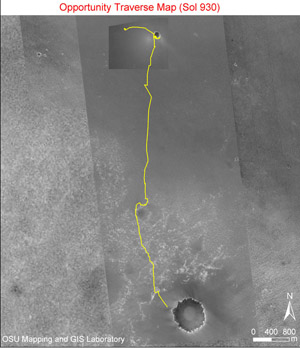|
It's the Astronomy Online non-Blog, or un-Blog.
Everyone has a blog now and since I am no follower of trends, I decided to merge the blog with the website. And I don't want to neglect the website in favor of posting on the blog.
These are the pages that were on the blog of old:
- Home
- Archive (Index of Pages)
- Me
- Current Trends
- Links
- Soho Live
Links:
Google Maps - Mars
Google Maps - Moon
HiRISE
HiRISE - MRO Imaging
Mac Singularity
Meade4M
Slackerpedia Galactica
Software for the Mac
Starry Night Online
Venus Maps
More Favorites:


































Thank you for visiting!
|
|
 |
|
The Mars Mission - Update on the MER's:
The Mars Exploration Rovers Spirit and Opportunity are still operating after 2 years on Mars. While there is a host of data available from the MER website, there has yet been a summary of events and discoveries. What I did not realize is that while the rovers operate by tasks issued by the rover team here on planet Earth, much of the tasks are based on real time (well, sort of real time) data from the orbiting Mars Express Orbiter (which arrived at Mars on December 25, 2003). One of the instruments on the orbiter - the OMEGA (Observatoire pour la Mineralogie, l'Eau, les Glaces et l'Activité) spectral imager - has proven instrumental (no pun intended) in directing the rovers to potential sources of evidence for water.

Spirit at Columbia Hill
On January 4, 2004 the Spirit rover landed at Gusev crater. It was chosen because of its dendridic appearance suggestive of a past lake. What was discovered by Spirit was nothing more than basalts. The original 90 day mission of Spirit (Opportunity was also slated for 90 days) was spent examining largely unaltered basalts that indicate little evidence of water. Columbia Hill is a different story. 2.5 kilometers from Gusev lay Columbia Hill, a lava plain containing more than 10 different types of rock - mostly ejecta from past impacts. One special type of rock found is composed of basaltic sandstone with magnesium sulfates which strongly suggests the presence of water. The water would have been sub-surface, but brought to the surface by impacts (hence the combination basalt and magnesium).

The Path of Spirit - from Mars Express
In pure scientific fashion, the OMEGA on Mars Express detected iron and magnesium at Columbia Hill prior to the arrival of Spirit. It was this discovery by OMEGA that prompted the re-task of Spirit to confirm the detections at Columbia Hill.

Opportunity at Victoria Crater
On January 25, 2004, Opportunity arrived at Meridiani Planum. This location was chosen based on spectrographic evidence of hematite by the Mars Global Surveyor. Landing in Eagle crater, Opportunity had much better luck detecting evidence for water. Magnesium sulfate, calcium sulfate and iron sulfate (jarosite) were detected as well as hematite rich spherules suggestive of precipitated groundwater.

The Path of Opportunity - from Mars Express
Once again the OMEGA detects water bearing minerals at Endurance crater - Opportunities next stop. This very large crater finds much of the same type of sulfates, but much more acidic than the relatively alkali material at Meridiani. The suggestion is that surface water interacted with basalts that later interacted with ground water.

Opportunity from the Mars Reconnaissance Orbiter
The OMEGA and the MER's are a tag-team in the detection of water-bearing minerals on Mars. Water on the surface of Mars leads to the production of something called phyllosilicates. These would have formed very early in Martian history unlike the sulfates which results from groundwater interacting with surface basalts due to impacts (water under the surface of Mars, called permafrost). What is interesting: the pH levels of the phyllosilicates are almost neutral and the sulfates are somewhat alkali. This means the water would have been suitable for life. Future missions to Mars would most likely focus on these phyllosilicate rich areas in an effort to detect biosignatures.
Images Courtesy NASA/JPL-Caltech
Story Adapted from Science 29 September 2006: Vol. 313. no. 5795, pp. 1899 - 1901 DOI: 10.1126/science.1132311
Next Post | Previous Post | Back to Top
|
|

